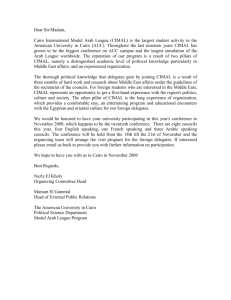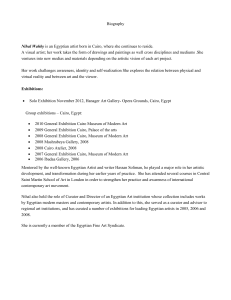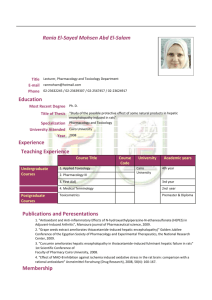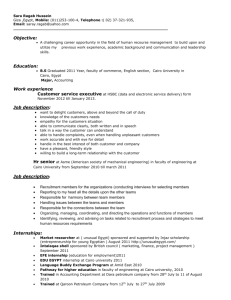Cairo Israel: Jerusalem Tel Aviv Morocco: Fez Marrakesh South Africa
advertisement
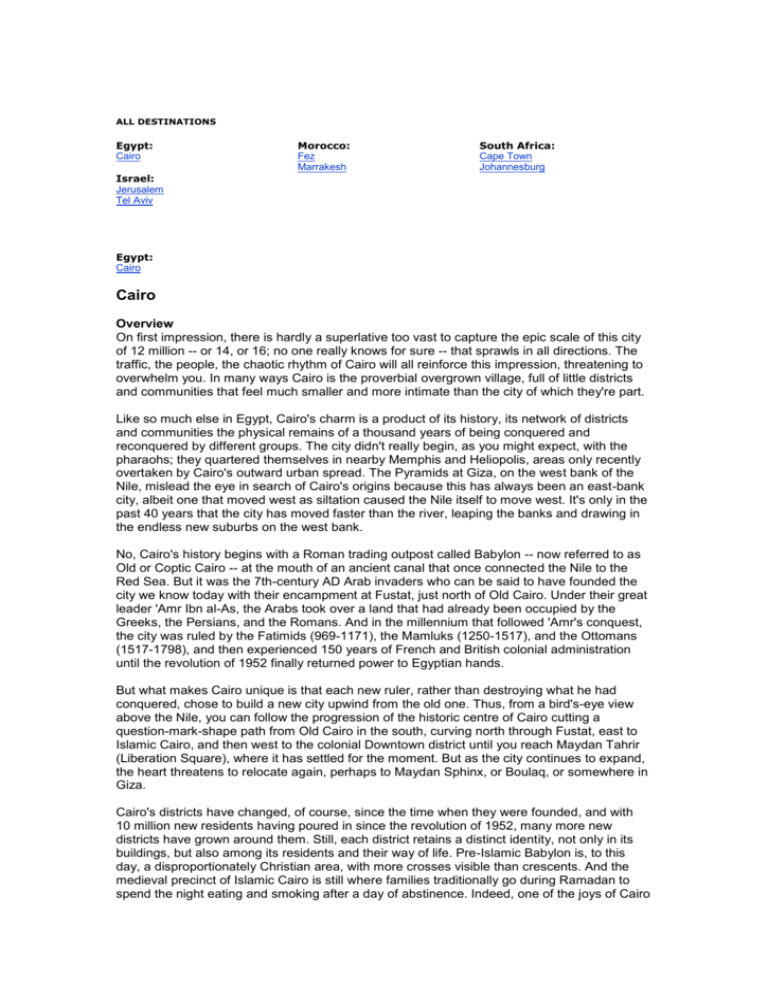
ALL DESTINATIONS Egypt: Cairo Morocco: Fez Marrakesh South Africa: Cape Town Johannesburg Israel: Jerusalem Tel Aviv Egypt: Cairo Cairo Overview On first impression, there is hardly a superlative too vast to capture the epic scale of this city of 12 million -- or 14, or 16; no one really knows for sure -- that sprawls in all directions. The traffic, the people, the chaotic rhythm of Cairo will all reinforce this impression, threatening to overwhelm you. In many ways Cairo is the proverbial overgrown village, full of little districts and communities that feel much smaller and more intimate than the city of which they're part. Like so much else in Egypt, Cairo's charm is a product of its history, its network of districts and communities the physical remains of a thousand years of being conquered and reconquered by different groups. The city didn't really begin, as you might expect, with the pharaohs; they quartered themselves in nearby Memphis and Heliopolis, areas only recently overtaken by Cairo's outward urban spread. The Pyramids at Giza, on the west bank of the Nile, mislead the eye in search of Cairo's origins because this has always been an east-bank city, albeit one that moved west as siltation caused the Nile itself to move west. It's only in the past 40 years that the city has moved faster than the river, leaping the banks and drawing in the endless new suburbs on the west bank. No, Cairo's history begins with a Roman trading outpost called Babylon -- now referred to as Old or Coptic Cairo -- at the mouth of an ancient canal that once connected the Nile to the Red Sea. But it was the 7th-century AD Arab invaders who can be said to have founded the city we know today with their encampment at Fustat, just north of Old Cairo. Under their great leader 'Amr Ibn al-As, the Arabs took over a land that had already been occupied by the Greeks, the Persians, and the Romans. And in the millennium that followed 'Amr's conquest, the city was ruled by the Fatimids (969-1171), the Mamluks (1250-1517), and the Ottomans (1517-1798), and then experienced 150 years of French and British colonial administration until the revolution of 1952 finally returned power to Egyptian hands. But what makes Cairo unique is that each new ruler, rather than destroying what he had conquered, chose to build a new city upwind from the old one. Thus, from a bird's-eye view above the Nile, you can follow the progression of the historic centre of Cairo cutting a question-mark-shape path from Old Cairo in the south, curving north through Fustat, east to Islamic Cairo, and then west to the colonial Downtown district until you reach Maydan Tahrir (Liberation Square), where it has settled for the moment. But as the city continues to expand, the heart threatens to relocate again, perhaps to Maydan Sphinx, or Boulaq, or somewhere in Giza. Cairo's districts have changed, of course, since the time when they were founded, and with 10 million new residents having poured in since the revolution of 1952, many more new districts have grown around them. Still, each district retains a distinct identity, not only in its buildings, but also among its residents and their way of life. Pre-Islamic Babylon is, to this day, a disproportionately Christian area, with more crosses visible than crescents. And the medieval precinct of Islamic Cairo is still where families traditionally go during Ramadan to spend the night eating and smoking after a day of abstinence. Indeed, one of the joys of Cairo is that its historic areas are still vibrant, living spaces and not open-air museums. The past here is more a state of mind than a historical fact -- and that, ultimately, is the way in which the city is truly overwhelming. Sights & Activities Cairo is big: just how big you'll see on the drive in from the airport. And what you see on the way into town, amazingly, is only half of it -- Cairo's sister city, Giza, on the west bank of the Nile, stretches to the pyramids, miles from Downtown. But if you are the sort of person who navigates by compass points and you think of the Nile as a giant north-south needle running through the centre of the city, exploring the city can be a breeze. The city's evolution has left it conveniently divided into districts, which, while they may blur together at the edges, become relatively straightforward targets for a day's exploration on foot. Much of the city was built in the 1960s, and the new areas hold relatively little of historical or cultural interest; they do, however, have the highest concentrations of hotels, restaurants, and shops. The older districts hold the most interesting sights. With the exception of Giza's pyramids, they are all on the east bank and easily accessible by taxi or metro. Old Cairo, also known as Mari Girgis, was the city's first district; it's on the east bank a couple miles south of most of current-day Cairo. Just north of it is Fustat, the site of the 7th-century Arab settlement. East of that is the Citadel. North of the Citadel is the medieval walled district of al-Qahira that gave the city its name. It is better known as Islamic Cairo. West of that is the colonial district. Known as Downtown, it is one of several districts -- including Ma'adi, Garden City, Heliopolis, and Zamalek -- laid out by Europeans in the 19th and 20th centuries. (The west-bank districts of Mohandiseen and Doqqi, by comparison, sprouted after the 1952 revolution.) Giza, a suburb of Cairo, is 12 km (8 mi) southwest of the city, a 45-minute taxi ride from Downtown, depending on traffic. It is here that the monuments most closely identified with Egypt stand: the timeless Sphinx and the Pyramids of Giza. The three pyramids of Khufu (Greek name: Cheops), Khafre (Chephren), and Menkaure (Mycerinus) dominate the Giza plateau. Surrounding this father-son-grandson trio are smaller pyramids belonging to their female dependents, and the mastabas (large, trapezoid-shape tombs) of their courtiers and relatives. A museum south of Khufu's Pyramid contains one of the most extraordinary artifacts of ancient Egypt, his own royal boat. The great Sphinx crouches at the eastern edge of the plateau. The pyramids, Sphinx, and some of the mastabas all date from the 4th Dynasty, while other mastabas date to the 5th and 6th Dynasties. Twenty-five km (16 mi) southwest of Cairo, Saqqara is best known as the site of the earliest stone pyramid constructed in Egypt, the Step Pyramid of Djoser. The site encompasses at least four other pyramid complexes of different dates, countless tombs from all eras of Egyptian history, and several animal necropolises. Saqqara is large, sprawling, and best covered on foot and by car. Dahshur, 33 km (21 mi) southeast of Cairo, is one of the most tranquil and awe-inspiring pyramid sites. Opened to the public in 1998, it contains five pyramids dating from the Old and Middle Kingdoms. Only one -- the North, or Red, Pyramid -- can be entered. Israel: Jerusalem Tel Aviv Jerusalem Overview The word "unique" is easy to throw around, but Jerusalem has a real claim on it. A mountainous walled city with a 5,000-year history, Jerusalem is sacred to more than one-third of the world's population. For Jews, Jerusalem has always been the focal point of devotion and spiritual yearnings, and for many, the psychic centre of their nationhood. "The world is like a human eye," wrote a Jewish sage in the 1st century AD: "the white is the ocean that girds the earth, the iris is the earth upon which we dwell, the pupil is Jerusalem, and the image therein is the Temple of the Lord." For 2,000 years Christians have also venerated Jerusalem as the place where their faith was shaped -- the site of the death, burial, and resurrection of Jesus of Nazareth. A famous Renaissance map shows the continents of Asia, Africa, and Europe as the leaves of a clover meeting in the holy city, a reality at once spiritual, historical, and (almost) geographically accurate. Islamic tradition identifies Jerusalem as the masjad el aqsa, the "farthermost place," from which Muhammad ascended to Heaven for his portentous meeting with God. It is the thirdholiest city for Muslims, after Mecca and Medina. A Muslim tradition claims that the great rock of Jerusalem's Mt. Moriah, site of the onetime Jewish Temple and present Dome of the Rock, is made of stones from the Garden of Eden. The focal point of any visit to Jerusalem is the one-square-kilometre walled Old City, with its four residential quarters (Christian, Jewish, Armenian, and Muslim) and the enormous Temple Mount, or Noble Sanctuary. It is a sensual mix of exotic sights, sounds, and smells. Step outside the Old City and you'll see a modern metropolis of 700,000 -- not as cosmopolitan as Tel Aviv, but with many good restaurants, concert halls, markets, and highquality stores, as well as quaint neighbourhoods that embody an earlier simplicity. The city prides itself on its historical continuity; a municipal bylaw makes it mandatory to face even high-rise commercial buildings with the golden "Jerusalem stone," the local limestone that has served Jerusalem's builders from time immemorial. Indeed, to see these limestone buildings glow golden in the sunset is to understand the mystical hold Jerusalem has had on so many minds and hearts for so many thousands of years. Best of Jerusalem in 1 to 3 Days If You Have 1 Day: Highlights Catch the morning view from the Mount of Olives Observation Point. Enter the Old City through Jaffa Gate, and visit the Church of the Holy Sepulcher. Cut through the Arab bazaar to the Jewish Quarter to explore its archaeological treasures (and enjoy a good coffee). Head to the Western Wall, with a view en route of the Muslim shrines on the Temple Mount. Take a cab from Dung Gate to the Israel Museum (Dead Sea Scrolls, archaeology, Judaica, and art) or Yad Vashem (an Holocoaust museum). If You Have 1 Day: Christian Orientation Begin with an early view from the Mount of Olives Observation Point, and then walk down to the Garden of Gethsemane, with its ancient olive trees. If you're Catholic, add a visit to the Pater Noster Convent and Dominus Flevit church. Enter the Old City through the Lions' (St. Stephen's) Gates, and visit the Pools of Bethesda and St. Anne's Church (the healing of the lame man). The street becomes the Via Dolorosa: follow the Stations of the Cross to the Church of the Holy Sepulcher. Have lunch in the Christian or Jewish Quarters, explore the archaeological finds of the Jewish Quarter, and end at the Western Wall. If you're Protestant, don't miss the Garden Tomb on Nablus Road. If time allows, detour to Mt. Zion, with its Room of the Last Supper and Dormition Abbey, before the Western Wall. If You Have 3 Days: Highlights Begin with the view from the Haas Promenade; then explore the City of David. Enter the Old City at Dung Gate to visit the Western Wall, and perhaps the Western Wall Tunnel or Ophel Archaeological Garden. Have lunch in the Jewish Quarter, poke around its sights and stores, and leave the Old City via the Arab market and Jaffa Gate. End the day at the vibrant Machaneh Yehuda produce market. On the second day, visit the Church of the Holy Sepulcher. Head to Jaffa Gate for the tour of the Tower of David Museum, which covers Jerusalem's action-packed history with visuals, not artifacts. Cab over to the Israel Museum. If time allows, head to downtown Ben Yehuda Street for coffee and people-watching. Begin the third day at Yad Vashem, the Holocaust museum. Visit the Chagall Windows & Hadassah Hospital. Have lunch in picturesque Ein Kerem (with or without the Church of the Visitation). Take the rest of the afternoon off for a well-earned break at your hotel pool or in the stores. Tel Aviv Overview Proud residents call it the city that never stops, and if you don't believe them, just come around 4 AM, when you may find yourself waiting in line for a table at a café or stuck in a traffic jam on Hayarkon Street. The first impression Tel Aviv makes depends on the direction from which visitors enter. Glass office towers along the Ayalon Freeway, the city's ring road, showcase the latest trends in high-rise architecture. A dose of Israeli urban sprawl circa 1960 awaits those who come in via the neighbourhoods northeast of Old Jaffa along Kibbutz Galuyot Street, eventually easing into the area's own funky charm. Tel Aviv's Bauhaus and art deco masterpieces, which can be seen from the Ayalon Freeway and Yizhak Sade Street, are the pride of Centre City. Whatever the route, one thing is clear: Tel Aviv is the heart of Israeli commerce and culture, and its restaurants, art galleries, museums, and beaches are unmatched anywhere in the country. Best in 2 to 3 Days Spending two to four days in Tel Aviv is ideal. You'll be able to explore a variety of neighbourhoods and museums and still have time left over to cool off on the beach. A shorter stay will require a lot of action, though you'll still be able to catch the highlights. If You Have 2 Days Begin in Old Jaffa, wandering around the restored section and delving into the small galleries and shops. Enjoy a meal of fresh fish on the waterfront at the port, and walk along the coastal Tayelet (promenade) back to central Tel Aviv. Head for the trendy Sheinkin Street area to get a feel for the contemporary Israeli lifestyle, and if it's a Tuesday or Friday, walk over to the street fair created by local artisans along the Nahalat Binyamin Pedestrian Mall. Nearby, Rothschild Boulevard has good examples of the city's various architectural styles and periods, from Middle East-influenced to Bauhaus to latter-day steel and glass, and some of the city's best restaurants and cafés. On the second day, take in a museum on a subject that interests you: the Tel Aviv Museum of Art; the Eretz Israel Museum, with its excellent archaeological exhibits; or Beth Hatefutsoth (Diaspora Museum), which depicts Jewish life around the world throughout the ages; or the Palmach Museum. You may want to squeeze in some shopping after that, then spend a few hours doing what Tel Avivians do best -- beten-gav (tummy-back, in Hebrew) -- cooling off on the beach. If You Have 3 Days The Nahalat Binyamin Pedestrian Mall street fair (on Tuesday and Friday) and the Carmel Market are good places to start. From there, it's a hop, skip, and a jump to Sheinkin Street for a coffee break or lunch, window shopping, and people watching. Get in some beach time today and go out for a late dinner in the Old Port in north Tel Aviv. Spend the morning of the second day walking through Old Jaffa, including the flea market, and afternoon or early evening strolling around and shopping in Neveh Tzedek. If there's a performance at the Suzanne Dellal Center in Neveh Tzedek, make an evening of dinner and a show. Save browsing and shopping around the city center for the last day, and make sure to stroll the Tayelet along the beach front. Hit the museums then spend the latter part of the day in Jaffa; the atmosphere is very different at night. Try one of the Rothschild Boulevard restaurants tonight. Morocco: Fez Marrakesh Fez Overview Fez has long been recognized as Morocco's intellectual and spiritual nerve center. The Arab capital of Morocco -- as opposed to Meknes, the Berber capital -- it is an ancient center of learning, culture, and craftsmanship, home to the oldest university in the West and the world's largest still-functioning medieval quarter, with a population of 60,000 (one-tenth of the city's total). Built in the fertile basin of the Fez River -- the Oued Fez -- Fez el Bali (literally, Fez the Old) was founded in AD 808 by Moulay Idriss II, son of the founder of Morocco, Moulay Idriss I. The original and the most imperial of Morocco's Imperial Cities, Fez was the nation's capital in the 9th, 12th-14th, and 16th centuries. Fez el Djedid (New Fez) was founded in 1276 by the Merenid rulers, who needed extra space for their palaces as well as a sense of distance from the population itself. The Ville Nouvelle was built by the French after they established their protectorate in 1912. Sights & Activities Fez is a great religious and cultural centre. In many respects, it's a window on the past. Indeed, as you enter the old quarter of Fez el Bali, only the occasional television antenna reminds you that you're entering the third, not the second, millennium AD. This honeycomb of 9th-century alleys and passageways is the perfect medieval labyrinth, and exploring it is a real adventure: Hiring an official guide from the tourist office on your first day is definitely recommended. Fez is not really yours until you've become hopelessly lost and survived to tell the tale. Once you have a sense of the place, about the worst that can happen is that a nine-year-old hustler will offer to take you wherever you want to go. Five or 10 dirhams will more than satisfy his commercial instincts; and for another five and a clear explanation that you would now prefer to continue alone, he'll vanish. If you're shopping, note that all of Fez's major emporiums, especially carpet shops, have English-speaking guides who give excellent explanations. The pressure to purchase varies from shop to shop, but if you're accompanied by an official tourist office guide, he will generally allow you to extricate yourself from what can seem like endless negotiations. Marrakesh Overview Pearl of the South, Jewel of the South, The Rose City -- just a few of the nicknames Marrakesh has acquired over the years. The pearl and the jewel symbolize its importance as the centre of Morocco ever since it was a trading and resting place on the crossroads of ancient caravan routes from Timbuktu. The rose attests to a city still painted entirely in salmon pink, in keeping with the red-clay earth below. Once called Morocco City by foreign travellers, Marrakesh eventually lent its name to the country itself. Part Berber, part Arab, part African, Marrakesh is the heartbeat of Morocco, where palaces and monuments of unrivaled refinement sit calmly alongside the snake charmers and Gnaouan drums pulsing constantly from Djemâa el Fna Square -- the most exuberant marketplace in the world. Virtually unchanged since the Middle Ages, Marrakesh's solid ramparts encircle and protect its mysterious labyrinthine medina, which hides sultans' palaces, the ornate mansions of rich merchants, and some of the most colourful bazaars in the Arab world. Late in the afternoon, Moroccans as well as foreigners crowd the Djemâa el Fna to hear storytellers and musicians perform, be wooed by herbalists and acrobats, and watch smoke rise from the outdoor food stalls as vendors whip up a wild array of fried fish, meats, salads, and such Moroccan delicacies as lamb or beef stewed in an earthenware pot and left in hot ashes all day. This intoxicating city is for the eyes -- a place where even the refined elements have a roughness to them, yet what is rough has its own refinement. Apart from the many things to see and do, one of the most refreshing things about Marrakesh is that time slows down here. The helter-skelter of mopeds, Mercedes, donkey carts, and pedestrians in the streets is really just a mirage; beneath it all, you can feel a languor in the way people walk, the way they take time to stop and talk to each other, conducting their daily affairs much as their ancestors did. With its dramatic beauty and unhurried rhythm, the Jewel of the South can beckon even the most seasoned traveller to stop moving and stay forever. Five Ways to Experience Marrakesh Cafés Sitting in a café watching life go by is one of the Marrakshis's most popular recreations in both Djemâa el Fna and Gueliz. Most of the cafés right on Djemâa el Fna have rooftop terraces with magnificent views of the whole square, the rooftops of Marrakesh, and the Atlas mountains in the distance. The best time of day to take in this panorama is the magic sunset hour, when the city earns yet another nickname, Marrakesh the Red -- here the setting sun turns colors ranging from pale pink and orange to purple and red. Watch the sky glow while sipping mint tea out of a glass (never a mug) or Moroccan-style coffee with steamed milk and wait for the teeming world below to take on its nighttime aspect. Calèche Rides Calèches are green, canopied horse-drawn carriages used by the locals to get around Marrakesh and by travellers to see the sights. They hold four to five people and cost 60 DH per hour. Board a calèche to take a tour of the ramparts or a trip out to the Palmery, or to see the Majorelle, Menara, or Agdal gardens. Cycling Cycling around Marrakesh is fun and easy, as the city is flat and open. Ride to the Menara or Agdal gardens or out on the Casablanca road to the Palmery oasis circuit and back, 25 km (16 mi) in all. You can rent bikes opposite the Hotel Imperial Borj, in Hivernage; or outside the Hotel Safir Siaha, on the Casablanca road; or inquire with your hotel's front desk. Evening Strolls The souk is a hive of artisanal activity until about 8 PM, so a leisurely stroll before dinner can be an exercise in pure discovery. Don't shop (unless you find just what you want) -- just experience. You can't really get lost; if confusion threatens, just ask someone to point you back to the Djemâa el Fna. Stroll up or down Avenue Mohammed V with the rest of Marrakesh, always on its way to or from that magnetic square, or around Koutoubia Mosque's vast grounds and then on toward La Mamounia and Bab el Djedid on Avenue Houmman el Fetouki. Festivals Marrakesh's annual folklore festival of Moroccan music, theatre, and dance -- the Festival National des Arts Populaires de Marrakech -- draws performers from all over Morocco and may even include an equestrian event. Held in May or June on the grounds of El Badi Palace, the festival lasts about 10 days and usually offers an evening program at 8:30. Don't miss it if you're here; just check with the Moroccan Tourist Office, as the date is never confirmed until a month or so beforehand. Aïd el Arch, or Throne Day, the commemoration of the king's coronation, is always on July 30. Parades and fireworks create a festive ruckus, and throngs of people fill the streets to listen and dance to live music. Aïd el Seghrir celebrates the end of Ramadan and is felt largely as a citywide sigh of relief. Aïd el Kebir, the Day of Sacrifice, has a sombre tone; approximately 3½ months after Ramadan Muslims everywhere observe the last ritual of the pilgrimage to Mecca by slaughtering a sheep. The Youth Festival, La Fête de Jeunesse, held on July 9, celebrates children, who generally just run around the streets singing, dancing, and horsing around. South Africa: Cape Town Johannesburg Cape Town Overview Capetonians tend to look with pity on those who don't have the good fortune to live in their Eden. Their attitude is understandable -- Cape Town is indeed one of the world's fairest cities. Backed by Table Mountain, the city presides over a coastline of unsurpassed beauty: mountains cascading into the sea, miles of beaches, and 17th-century wineries snoozing under giant oaks. Modern South Africa was born here, and the city is filled with historic reminders of its three centuries as the sea link between Europe and the East. Best of Cape Town in 2 to 5 Days Whatever activities you hope to accomplish in Cape Town, head up Table Mountain as soon as the wind isn't blowing. Cape Town wind is notorious, and the mountain can be shut for days on end when there are gales. If You Have 2 Days On your first day take an early morning city walk to see the sights or take a half-day city tour. Take in the Company's Gardens, Castle of Good Hope, District Six Museum, the Bo-Kaap, and other historical highlights. For lunch, eat at one of the outside restaurants at the V&A Waterfront if the weather's good, inside if it's not. Visit the various waterfront attractions, including the Two Oceans Aquarium, especially if you have children. Then you can dine either at the Green Dolphin, where you can listen to terrific jazz, or go uptown to one of the city's many excellent restaurants, followed by the theatre, ballet, or opera at the Artscape or Baxter theatre complexes. For a real taste of contemporary African music, head for pulsing marimba music at Mama Africa. The next morning take a Robben Island tour, which takes 3½ hours. On your return go straight to the Lower Cable Station, and ride to the summit of Table Mountain (if you didn't do this first thing). Take some sandwiches with you, and hike one of the trails -- for a few minutes or a few hours -- until you find a glorious spot to sit and enjoy the view. When you come down from the mountain, drive to Camps Bay and kick off your shoes to stroll along the beach. To round out the evening, find a sophisticated sea-facing bar for a drink before going on to dinner. If You Have 5 or More Days Spend the first day or two exploring Cape Town. Pop in to museums and galleries, and wander around the Bo-Kaap, an old Cape Malay area with cobblestone streets and quaint buildings. One of the best ways to understand the city is to take a walking tour with Footsteps to Freedom. On the afternoon of the second day head for Table Mountain. On the morning of Day 3 explore Robben Island, and, on your return, lunch at the Waterfront. In the afternoon you might visit the castle or have high tea at the Mount Nelson Hotel. In the evening head out to the vibey suburb of Observatory for dinner, and then wander down Lower Main Road, perhaps popping in for a drink or late-night coffee at a café. If you want something closer to the city, try de Waterkant, another exciting area for a drink and dinner. Party animals will find plenty of clubs as well. On Day 4 drive out to the Constantia winelands. Visit the estates, enjoy the countryside, do a little wine tasting, have lunch, and then in the afternoon drive over Constantia Nek to Hout Bay. From the harbour, take an early afternoon cruise to Seal Island. For a more adventurous activity, admire the sunset from the back of a horse at Noordhoek or from a kayak out at sea. If the conditions are right, you can do a tandem paraglider flight off Lion's Head, landing just in time for cocktails overlooking the beach. Even if you don't paraglide here, have dinner on this side of the mountain, at Green Point, Sea Point, or Camps Bay. Day 5 is penguin day. Wend your way along the False Bay coast to Boulders Beach, in the Table Mountain National Park, where you'll find African penguins in profusion. This is one of the few mainland sites where these comical little creatures live and breed. Then grab your map and follow the road to the Cape of Good Hope and Cape Point. You can take the steep walk to the point or take the funicular. It looks as if this is where the Indian and Atlantic oceans meet -- sometimes there is even a line of foam stretching out to sea -- but of course it's not. No matter, it's a dramatic spot. For a late lunch make your way back to the pretty fishing village of Kalk Bay, where the streets are lined with antiques shops and there are plenty of excellent restaurants to relax in. Back in Cape Town for the last night, you can have a drink at the Bascule bar at the Cape Grace (at the Waterfront) and watch the gulls wheel overhead against a backdrop of Table Mountain. Chances are, you won't ever want to leave. Johannesburg Overview Johannesburg is a huge urban sprawl, and though all the hotels and major malls have moved to the northern suburbs, some of the city centre is enjoying a renaissance. The area near City Hall and the Newtown Cultural Precinct has been completely overhauled. The streets have been gentrified with stylish lighting, paving, and small wooden sculptures on concrete plinths. Soweto, too, is well worth a visit, although you should take a guided tour. Jo'burg is a sprawling city that can seem rather boring if you don't know what to look for, where to go, and how to interpret what you're seeing. Though Johannesburg is rarely associated with the great outdoors, it has its share of pleasant parks and nature reserves hugging the outskirts of the city. In the outer areas it's possible to envision how the inland plateau must have appeared to the region's first settlers. Beyond this to the north lies the largely unspoiled Magaliesberg region. Here you can get a restful break amid lovely mountain scenery, farmlands, and quiet country roads. Also close by is the fascinating Cradle of Humankind, a World Heritage Site with a spectacularly rich fossil record. It was here that the remains of the first hominid, Australopithecus, were found, as well as records of the earliest known use of fire. Best of Johannesburg in 1 to 4 Days If You Have 1 or 2 Days If you have only one day in Jo'burg, take a tour of Soweto or Alexandra, see the Apartheid Museum, go shopping, and then head out to Muldersdrift for a wild and wacky African dinner at the Carnivore restaurant. If you have a second day, focus on what interests you most: perhaps a day trip to the Cradle of Humankind, where you'll explore the sites of some of the latest and most significant paleontological discoveries in the world, or a jaunt to Sun City. You could start the day off with a balloon ride and then amble through the Magaliesberg area, wandering from coffee shop to art studio. Other options include a tour of the Cullinan Diamond Mine, near Tshwane, or a visit to Gold Reef City and the Apartheid Museum. Each of these options could take up a half or full day. If You Have 3 or 4 Days Spend Days 1 and 2 as first described above, overnighting, perhaps, at the Misty Hills Country Hotel after your visit to the Cradle of Humankind. En route back to Johannesburg on Day 3, visit the Cullinan mine and do a short walking tour of central Pretoria. On Day 4 do some shopping in the morning, visiting the Bruma flea market or the African market outside Rosebank Mall. Alternatively, if you'd rather mix your energy with some peace and quiet, you can stay in a chalet at Mountain Sanctuary Park, in the Magaliesberg, for a night or two, and go for long walks.



